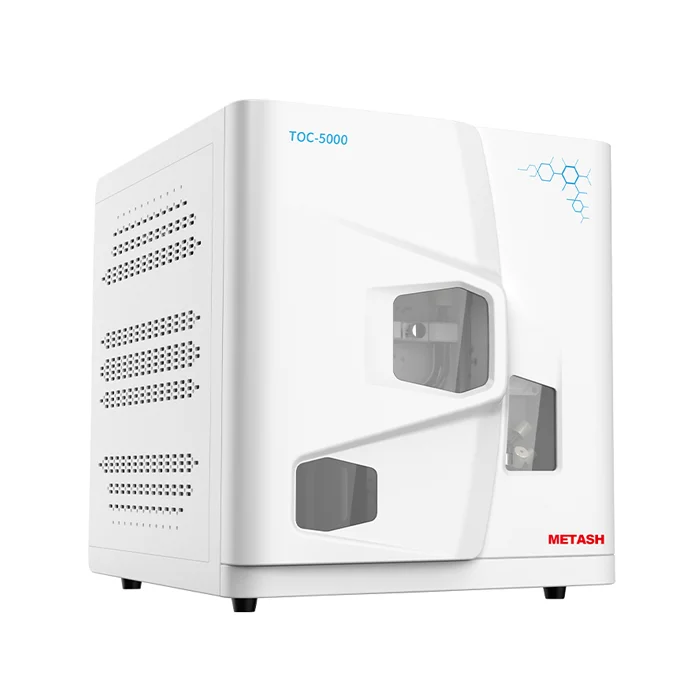- This topic is empty.
-
AuthorPosts
-
2025-08-06 at 6:03 pm #10232
In the vast expanse of the ocean, where the blue waves cradle the origins of civilization and hold the key to sustainable development, the importance of accurate and reliable seawater quality monitoring cannot be overstated. As the global community increasingly recognizes the critical role of marine ecosystems in climate regulation and economic prosperity, the need for advanced analytical tools to assess and protect these environments has become paramount. In this blog post, Metash, a high performance laboratory analytical equipment supplier, will share the importance of TOC total organic carbon analyzer for seawater detection, providing valuable data to environmental scientists, policymakers, and various industries.

Significance of TOC in Marine Environments
The ocean is a vast reservoir of organic carbon, storing approximately 38,000 billion tons of it, which is equivalent to 50 times the amount of carbon in the atmosphere. Dissolved organic carbon (DOC) alone accounts for 95% of the total organic carbon (TOC) in seawater, making it a crucial component in the global carbon cycle. The dynamics of TOC in seawater not only reflect the productivity of marine ecosystems but also indicate the health of these environments. Elevated levels of TOC in seawater can be a sign of pollution from industrial discharges, agricultural runoff, or other anthropogenic activities, which can have detrimental effects on marine life, water quality, and the overall balance of the marine ecosystem.
Moreover, with the increasing focus on climate change mitigation and adaptation, understanding the carbon sequestration capacity of the oceans has become essential. Accurate TOC measurements are vital for assessing the potential of marine ecosystems to act as carbon sinks, which can contribute to the global efforts to reduce greenhouse gas emissions. The TOC-5000 RD Analyzer can provide the data necessary to support informed decision-making and effective environmental management strategies.

TOC-5000 RD Analyzer: A Technological Breakthrough
TOC-5000 RD Total Organic Carbon Analyzer is equipped with advanced features that enable it to deliver precise and reliable TOC measurements even in high-salinity environments. One of the key innovations of the TOC-5000 RD is its enhanced halogen removal device, which effectively mitigates the risks of catalyst degradation and detector damage caused by the high salt content in seawater.
The analyzer employs a combination of differential subtraction method and spike recovery validation to ensure the accuracy of TOC measurements. The differential subtraction method involves the calculation of TOC by subtracting the inorganic carbon (IC) content from the total carbon (TC) content in the sample. This method is particularly effective in dealing with the high background levels of inorganic carbon in seawater, which can interfere with the accurate determination of TOC. The spike recovery validation, on the other hand, involves adding a known amount of organic carbon to the sample and measuring the recovery rate to verify the accuracy of the analysis. This dual approach ensures that the TOC measurements obtained are both precise and reliable.
Experimental Validation and Results
To demonstrate the effectiveness of the TOC-5000 RD analyzer in measuring TOC in seawater, a series of experiments were conducted in accordance with the national standard "HY/T 150-2013 Determination of Organic Carbon in Seawater – Nondispersive Infrared Absorption Method." The experiments involved the preparation of standard curves for IC and TC using sodium bicarbonate and potassium hydrogen phthalate, respectively. The results showed that both the IC and TC standard curves exhibited excellent linearity, with correlation coefficients (R²) of 1.0, indicating the high precision and reliability of the analyzer.
In the actual seawater sample analysis, the TOC-5000 RD analyzer was able to accurately measure the TOC content in the samples, with an average measured value of 2.1214 mg/L. The spike recovery experiment, which involved adding a known concentration of organic carbon to the seawater sample, yielded a recovery rate of 95.17%, further validating the accuracy and reliability of the analyzer. These results demonstrate that the TOC-5000 RD is capable of providing precise and reliable TOC measurements in seawater, making it an ideal tool for marine environmental monitoring.
Applications and Future Prospects
The TOC-5000 RD Total Organic Carbon Analyzer has a wide range of applications in marine environmental monitoring. It can be used to assess the impact of industrial discharges on seawater quality, monitor the effectiveness of pollution control measures, and evaluate the carbon sequestration capacity of marine ecosystems. Additionally, the data obtained from the analyzer can support the development of early warning systems for harmful algal blooms (red tides), which can have significant economic and ecological impacts.
As the global community continues to strive for sustainable development and the protection of marine environments, the TOC-5000 RD analyzer is poised to play a crucial role in these efforts. Its ability to provide accurate and reliable TOC measurements in seawater offers a powerful tool for scientists, policymakers, and industries to make informed decisions and take effective actions to safeguard the health and productivity of our oceans.
In conclusion, the TOC-5000 RD Total Organic Carbon Analyzer represents a significant leap forward in the field of marine environmental monitoring. Its advanced features and proven accuracy make it an indispensable tool for assessing the health of marine ecosystems and supporting sustainable development initiatives. As we look to the future, the continued development and application of such advanced analytical tools will be essential in our efforts to protect and preserve the invaluable resources of our oceans for generations to come.
http://www.metashcorp.com
Metash -
AuthorPosts
- You must be logged in to reply to this topic.